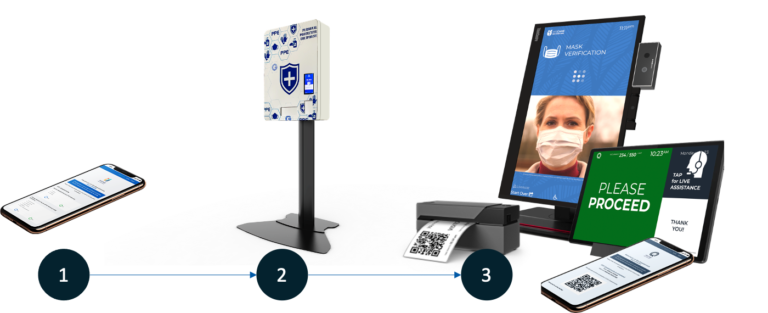Louis Brier case study
Vancouver long-term care facility deploys LiveAssist™ and co-creates an elevated solution for other long-term care providers.
In contract with Vancouver Coastal Health Authority, Louis Brier Home and Hospital is home to 215 residents supported by 400 employees. Louis Brier strives to be leaders in the provision of care through excellence in service, clinical practice, education, and community outreach.
LiveAssist™
platform configuration

Louis Brier was looking for a solution to automate labour-intensive entry procedures, eliminate paper records and add increase security at the door.
- Number of doors – 3: main hospital, residence, and parking
- Verification modules – 4: questionnaire, mask, temperature, and visitor type specified time of visit)
- Notification set based on staff shifts – 4
- Visitor types – 6: visitor, staff, residents, contractors, volunteers, medical professionals
- Check-in questionnaires – 2
- Occupancy load
- Mobile check-in questionnaire
- Tablet fast verification – 2
- Tablet exit – 3
- Kiosk completed check-in
- Badge printing
- PPE distribution
- Access control
Story so far…
Early in the pandemic, Louis Brier realized their labour and paper-intensive entry procedures weren’t sustainable.

As Megan Goudreau, Manager of Integration Quality and Risk Management, at Louis Brier explains, “We were looking for a system that would allow us to track who is entering and exiting our building, including our residents. We wanted to be able to see the number of people in the building at a time. And then we wanted to increase security at the door.”
Megan and her team shopped around a little bit and started asking questions of vendors.
“What we liked about LiveAssist™ was their desire to create a system with us. They came to us and proposed to work with us to build a platform for long-term care. A lot of other companies, we would ask them a few questions and they would say no. Their systems were fixed and inflexible,” says Goudreau.
Louis Brier was also required to ensure they selected a Canadian company for privacy of information per Vancouver Coastal Health guidelines.
Megan’s team presented a recommendation to the CEO and directors and they decided to move forward with LiveAssist™.
At the outset, Megan was thinking about the data LiveAssist™ gathers and how she might glean insights into how many residents were leaving the building and why.
“I wanted to know was who was receiving contact with the outside world. Who was getting visitors or having practitioners come in. By that same light, who then is potentially cut off from the community? Who might feel isolated? With those insights we can start to see what else we might do for them, to improve the quality of care we provide.”
The journey so far with LiveAssist™ has been memorable because of operating during the pandemic. New requirements were issued by Vancouver Coastal Health, the questions required during entry changed.
“We started with a set of requirements, and they just kept changing and shifting, and LiveAssist™ kept shifting with us. So that’s really great. We already see three and four steps ahead, and we feel that LiveAssist™ sees that too.”
If Goudreau were asked to describe LiveAssist™ to a peer, she would say the platform has the ability to move with you. “I have yet to come across a limitation that the team isn’t able to find a workaround and figure something out. Even if the system might appear a certain way, the team is ready and able to tailor it to needs,” she says.
She sees capacity in LiveAssist™ beyond screening and basic data gathering. “I see it as a way to standardize your intake process and your ability to pull information and provide data for quality improvement.”
“It gives you a better idea about what’s going on in your building, on the numbers in your building, it’s also going to give you a better idea about what kind of services need to be provided or where it’s lacking,” says Goudreau.
This work together with LiveAssist™ wouldn’t have happened without the team. In fixing bugs along the way,
This work together with LiveAssist™ wouldn’t have happened without the team. In fixing bugs along the way, in reworking parts of the platform to better suit the needs in long-term care. “The LiveAssist™ team as a whole is very responsive, very motivated and eternally optimistic,” says Goudreau.
This experience has been a remarkable one. “This has been a really great and unique experience. At the start, we kind of just had these ideas. And here we are with top-of-the-line systems in place. We’re pulling data like we’ve never been able to before,” she says.
Long-term care has evolved and more than ever is becoming a place to provide cutting-edge services, to constantly evolve while maintaining best practices, according to Goudreau.
“Providing the best possible care is essential, because we’re getting a different kind of resident. Now typically, our residents are coming to us with very complex medical conditions. More and more we are being asked to provide the kind of care that might have been provided in a hospital,” says Goudreau. “Along with that I see the benefit of having a system like LiveAssist™ it’s an extra step up. We’re elevating our services; we’re elevating the things we’re offering our clients and our stakeholders”
